

From Vilcabamba in southern Ecuador we traveled directly to Piura in northern Peru and then spent a couple of weeks visiting some of the famous coastal pre-Colombian ruins. We visited the ruins of the largest adobe (mud) city in the world - Chan Chan - quite incredible.
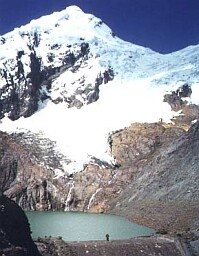
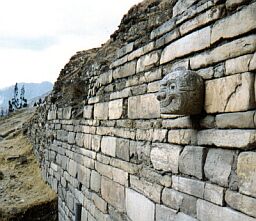 Next we
traveled up to the Cordillera Blanca (White Mountains) and did some spectacular hiking
among the snow-caps. On one hike I climbed up to almost 5,000m, it was pretty tough up
there as the air was so thin! The views however were certainly worth it! While up in the
cordillera we visited the famous Chavin Fortress, belonging to one of the very earliest
pre-Colombian cultures. The ruins with their mountain setting were certainly impressive
and well worth the trip.
Next we
traveled up to the Cordillera Blanca (White Mountains) and did some spectacular hiking
among the snow-caps. On one hike I climbed up to almost 5,000m, it was pretty tough up
there as the air was so thin! The views however were certainly worth it! While up in the
cordillera we visited the famous Chavin Fortress, belonging to one of the very earliest
pre-Colombian cultures. The ruins with their mountain setting were certainly impressive
and well worth the trip.
From the Cordillera Blanca we traveled down to the capital, Lima, where we visited a couple of the famous museums on the pre-Colombian cultures. The Museo de La Nacion had a particularly fine display on Lord Sipan - whose tomb that had recently been uncovered and was recognized as the richest such find in the Americas!
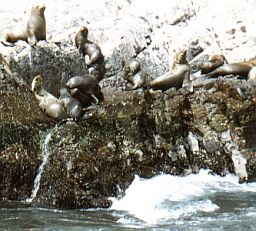 After Lima we traveled further south to Pisco, where we took a boat trip out to the
beautiful Ballestas Islands. Out at the islands we saw penguins, thousands of curious sea
lions and many rare sea-birds, including the huge albatross. Again these island were known
as 'The Poor Man's Galapagos', a substitute for those travelers who preferred not to
splash out a 1000 dollars to visit the actual Galapagos Islands. Next we traveled further
down the Peruvian coastal desert to a beautiful oasis town called Huacachina, which was
amongst gigantic 600 feet sand dunes. We climbed to the top of the dunes and had great
views of the sea of sand that stretched to the horizon! Several people put their sand
boarding skills to the test, but Steve and I preferred to just enjoy the views and watch
the sunset.
After Lima we traveled further south to Pisco, where we took a boat trip out to the
beautiful Ballestas Islands. Out at the islands we saw penguins, thousands of curious sea
lions and many rare sea-birds, including the huge albatross. Again these island were known
as 'The Poor Man's Galapagos', a substitute for those travelers who preferred not to
splash out a 1000 dollars to visit the actual Galapagos Islands. Next we traveled further
down the Peruvian coastal desert to a beautiful oasis town called Huacachina, which was
amongst gigantic 600 feet sand dunes. We climbed to the top of the dunes and had great
views of the sea of sand that stretched to the horizon! Several people put their sand
boarding skills to the test, but Steve and I preferred to just enjoy the views and watch
the sunset.
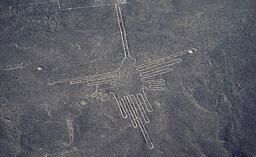
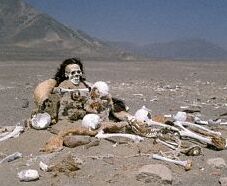 After the oasis
we continued south to the town of Nazca, where we took a flight in a little light aircraft
over the famous Nazca Lines. The Nazca lines were etched into the desert floor over 1,000
years ago by various pre-Colombian cultures. There are many theories to the original
meaning of the mysterious lines - for astronomy, pathways for the spirits to follow, and
even runways for alien spacecraft! We also visited the bizarre desert cemetery just
outside the town of Nazca. The extreme dryness of the desert has preserved many eerie
mummies. Years of grave robbers have left the desert strewn with the remains of these
mummies.
After the oasis
we continued south to the town of Nazca, where we took a flight in a little light aircraft
over the famous Nazca Lines. The Nazca lines were etched into the desert floor over 1,000
years ago by various pre-Colombian cultures. There are many theories to the original
meaning of the mysterious lines - for astronomy, pathways for the spirits to follow, and
even runways for alien spacecraft! We also visited the bizarre desert cemetery just
outside the town of Nazca. The extreme dryness of the desert has preserved many eerie
mummies. Years of grave robbers have left the desert strewn with the remains of these
mummies.
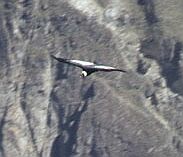 After
the coastal desert we traveled up to the city of Arequipa, in the highlands. Arequipa,
known as 'Ciudad Blanca', had many impressive buildings constructed of a white stone.
While in the city we visited the famous Santa Catalina Convent and went to a museum
displaying a recently discovered frozen Inca princess. The frozen mummy was displayed in a
refrigerated class case - an eerie experience. From Arequipa we traveled out to the Colca
Canyon, "The deepest canyon in the world", and did some spectacular hiking. In
the canyon we climbed to a mirador and saw many of the massive condor birds circling below
us. The mirador is regarded as one of the best places in the world to observe these
majestic boards.
After
the coastal desert we traveled up to the city of Arequipa, in the highlands. Arequipa,
known as 'Ciudad Blanca', had many impressive buildings constructed of a white stone.
While in the city we visited the famous Santa Catalina Convent and went to a museum
displaying a recently discovered frozen Inca princess. The frozen mummy was displayed in a
refrigerated class case - an eerie experience. From Arequipa we traveled out to the Colca
Canyon, "The deepest canyon in the world", and did some spectacular hiking. In
the canyon we climbed to a mirador and saw many of the massive condor birds circling below
us. The mirador is regarded as one of the best places in the world to observe these
majestic boards.
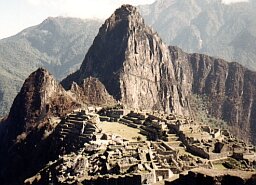
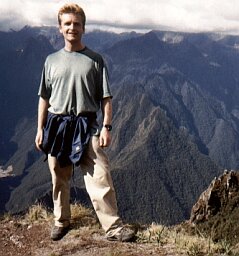 From
Arequipa we traveled up to the ancient capital of the Incas, Cusco. Cusco was at an
altitude of 3,300m so it was quite fresh. Cusco was also the tourism capital of South
America and so there were many great restaurants and a lively nightlife. From Cusco
we took the 'local' train up to Aguascalientes and then did the Inca Trail trek to the
famous lost city of the Incas, Machu Picchu. Although I had seen hundreds of pictures of
Machu Picchu, it was still a magical experience arriving at the Sun Gate at dawn, and
looking down on the ruins of the ancient Inca city. The ruined city was built on a high
saddle which dropped away sharply on both sides.
From
Arequipa we traveled up to the ancient capital of the Incas, Cusco. Cusco was at an
altitude of 3,300m so it was quite fresh. Cusco was also the tourism capital of South
America and so there were many great restaurants and a lively nightlife. From Cusco
we took the 'local' train up to Aguascalientes and then did the Inca Trail trek to the
famous lost city of the Incas, Machu Picchu. Although I had seen hundreds of pictures of
Machu Picchu, it was still a magical experience arriving at the Sun Gate at dawn, and
looking down on the ruins of the ancient Inca city. The ruined city was built on a high
saddle which dropped away sharply on both sides.
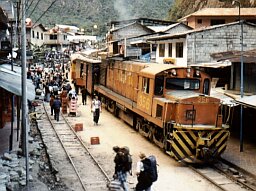
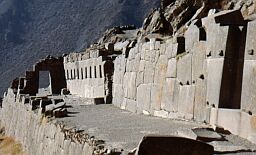 After
exploring the fabulous ruins of Machu Picchu we climbed back down to Aguascalientes. We
then caught a train down to the town of Ollantaytambo. Ollantaytambo also had some
fabulous Inca ruins with some fine Inca stone work. We spent a night in the town and
visited the ruins in the morning just after sunrise. To save time we caught an express bus
to Cuzco rather than using the train. Back in Cuzco we passed another week enjoying the
lively traveler social scene.
After
exploring the fabulous ruins of Machu Picchu we climbed back down to Aguascalientes. We
then caught a train down to the town of Ollantaytambo. Ollantaytambo also had some
fabulous Inca ruins with some fine Inca stone work. We spent a night in the town and
visited the ruins in the morning just after sunrise. To save time we caught an express bus
to Cuzco rather than using the train. Back in Cuzco we passed another week enjoying the
lively traveler social scene.
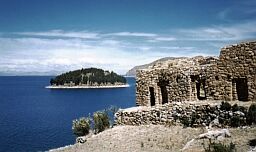
 After
Cusco we took the train south to the legendary Lake Titicaca. The lake at nearly 4,000m is
the highest navigable lake in the world. The scenery was amazing with the deep blue of the
lake, the bleak surrounding altiplano and the snow-caps of the Cordillera Real. We took a
tour out to some of the islands and spent a night at a very traditional/primitive island
village. We also visited the Isla del Sol, which is the legendary birthplace of the Incas
- a beautiful island. Next we traveled around the lake and took the ferry across to
Bolivia.
After
Cusco we took the train south to the legendary Lake Titicaca. The lake at nearly 4,000m is
the highest navigable lake in the world. The scenery was amazing with the deep blue of the
lake, the bleak surrounding altiplano and the snow-caps of the Cordillera Real. We took a
tour out to some of the islands and spent a night at a very traditional/primitive island
village. We also visited the Isla del Sol, which is the legendary birthplace of the Incas
- a beautiful island. Next we traveled around the lake and took the ferry across to
Bolivia.
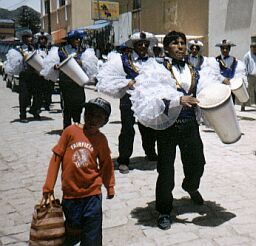 We
entered Bolivia in mid October and traveled quickly to the capital, La Paz. La Paz is the
highest capital in the world at nearly 4,000m (13,000 feet) and is the most Indian capital
in South America. It is a beautiful city built in a bowl at the foot of a 6,000m
snow-capped mountain. Away from the modern central high-street, the whole city is a huge
street market, where you can buy just about anything. At one street corner you could buy
Lama fetuses to guard against evil spirits! The city had an amazing blend of the old and
new with smartly dressed executives walking side by side traditionally dressed Indian
women.
We
entered Bolivia in mid October and traveled quickly to the capital, La Paz. La Paz is the
highest capital in the world at nearly 4,000m (13,000 feet) and is the most Indian capital
in South America. It is a beautiful city built in a bowl at the foot of a 6,000m
snow-capped mountain. Away from the modern central high-street, the whole city is a huge
street market, where you can buy just about anything. At one street corner you could buy
Lama fetuses to guard against evil spirits! The city had an amazing blend of the old and
new with smartly dressed executives walking side by side traditionally dressed Indian
women.
From La Paz we took a flight down into the Bolivian Amazon Basin on the Bolivian military airline, TAM. It was an amazing flight beginning in the bleak altiplano, flying over the spectacular snow peaks of the Cordillera Real and then descending into the Amazon jungle! We landed on a grass airstrip at the village of Rurrenabaque, which is on the Rio Beni, an Amazon tributary. It was quite a shock to the system stepping out into 35 degrees and almost 100% humidity, after the fresh dry climate of La Paz.
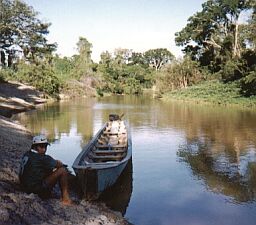
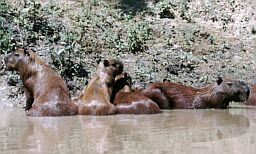 From
Rurrenabaque we took a boat up river to a jungle lodge, where we stayed for three days.
One day at the jungle lodge I took a walk to a swim hole - in the first 100m a huge
tarantula ran across my path, then the fish in the swim hole bit me, and finally on the
walk back an insect nest brushed against my head and I had hundreds of insect larvae
crawling in my hair!! After the jungle lodge we went on a 3 day camping tour of the Pampas
(wetlands) and saw many incredible animals, including pink river dolphins, hundreds of
alligators, turtles, huge 12 feet anaconda snakes and of course millions of nasty insects!
From
Rurrenabaque we took a boat up river to a jungle lodge, where we stayed for three days.
One day at the jungle lodge I took a walk to a swim hole - in the first 100m a huge
tarantula ran across my path, then the fish in the swim hole bit me, and finally on the
walk back an insect nest brushed against my head and I had hundreds of insect larvae
crawling in my hair!! After the jungle lodge we went on a 3 day camping tour of the Pampas
(wetlands) and saw many incredible animals, including pink river dolphins, hundreds of
alligators, turtles, huge 12 feet anaconda snakes and of course millions of nasty insects!
After the Bolivian Amazon we traveled up to the beautiful village of Coroico, in the Yungas region. The village was at an altitude of 1,750m, so it had a pleasant sub-tropical climate. We splashed out for a hotel with a pool - $5/night! We spent a few days in Coroico relaxing and recovering from all of our insect bites we had collected in the Jungle. From Coroico we traveled to another Yungas town Sorata (Altitude 2,700m), where we hiked to a cave and went swimming in an underground river. The cave was full of squeaking bats and was pitch black, so it was quite spooky! The morning after we arrived in Sorata, the bus that we had traveled on the day before went over a cliff and plunged 500 feet - 32 people were killed and 20 badly injured. We had certainly had a very close shave! After the Yungas we returned to La Paz and spent a week enjoying the city. La Paz had a great atmosphere and there was a good night life scene, so we had fun.
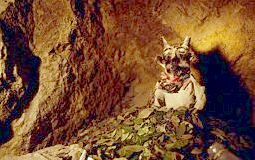 From
La Paz we traveled further south in Bolivia to Potosi, the highest city of its size in the
world (4,070m). Here we took a tour with an ex-miner into one of the infamous silver mines
of the Cerro Rico (Rich Hill). These mines have been operating since the middle of the
sixteenth century, and the silver they produced underwrote the Spanish empire for hundreds
of years. Over the centuries millions of slaves were used to extract the silver in
appalling conditions - many thousands died in the mines. We had to clamber, crawl and
climb through the dark, claustrophobic passages, each holding one of the traditional
carbide gas lamps. The miners we saw were still using the original manual methods to drill
out blasting holes in the rock face. It was a pretty unusual experience and certainly not
for people afraid of confined places.
From
La Paz we traveled further south in Bolivia to Potosi, the highest city of its size in the
world (4,070m). Here we took a tour with an ex-miner into one of the infamous silver mines
of the Cerro Rico (Rich Hill). These mines have been operating since the middle of the
sixteenth century, and the silver they produced underwrote the Spanish empire for hundreds
of years. Over the centuries millions of slaves were used to extract the silver in
appalling conditions - many thousands died in the mines. We had to clamber, crawl and
climb through the dark, claustrophobic passages, each holding one of the traditional
carbide gas lamps. The miners we saw were still using the original manual methods to drill
out blasting holes in the rock face. It was a pretty unusual experience and certainly not
for people afraid of confined places.
After Potosi we traveled to Sucre, the judiciary capital of Bolivia. Sucre was a really pleasant university town with plenty of trendy cafes, a beautiful shady plaza and many fine old colonial buildings. The city was at an altitude of 2,800m, so the weather was like perfect English springtime. In Sucre Steve, my travel companion, received an email saying that one of his friends was flying out to La Paz on Friday 28th November, so he decided to quickly return to La Paz to meet him. I continued on to Cochabamba, Bolivia's third largest city. Cochabamba has an almost perfect climate (Altitude 2,500m), and with a population of over 400,000, there are enough people to make it a happening place. I spent four or five days relaxing an enjoying the night-life scene! Next I returned to La Paz to meet up with Steve and his friend. We spent another five days in La Paz generally enjoying the city and its night life.
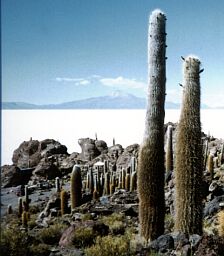
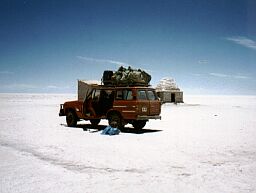 From La
Paz we traveled down to the south-west corner of Bolivia to a windswept altiplano town
called Uyuni. From Uyuni we took a three day tour into the famous dry salt lakes of Salar
de Uyuni and the spectacular remote areas of the south-west of Bolivia. The trip was
absolutely amazing and the landscapes were probably the most bizarre I have ever seen! The
actual Salar was a huge dry salt lake, probably more than 50km in diameter, brilliant
white - it looked like a gigantic ice-field of the Arctic! In the middle of the Salar we
stopped on an `Island´ which had giant cacti growing up to 10m high. From the Salar the
tour took us further south to an area of active volcanoes, powerful geysers and boiling
mud pools - fascinating! We also visited spectacularly colorful lakes full of Flamingoes.
Between the sights we traveled through incredibly barren high-altitude desert - up to
5,000m. The night time temperatures dipped to -5 Celsius, but the days were pleasantly
warm around 15 Celsius. The tour took us right to the un-manned frontier with Chile, where
a Chilean tour agency picked us up and drove us down to the first border town, San Pedro
de Atacama.
From La
Paz we traveled down to the south-west corner of Bolivia to a windswept altiplano town
called Uyuni. From Uyuni we took a three day tour into the famous dry salt lakes of Salar
de Uyuni and the spectacular remote areas of the south-west of Bolivia. The trip was
absolutely amazing and the landscapes were probably the most bizarre I have ever seen! The
actual Salar was a huge dry salt lake, probably more than 50km in diameter, brilliant
white - it looked like a gigantic ice-field of the Arctic! In the middle of the Salar we
stopped on an `Island´ which had giant cacti growing up to 10m high. From the Salar the
tour took us further south to an area of active volcanoes, powerful geysers and boiling
mud pools - fascinating! We also visited spectacularly colorful lakes full of Flamingoes.
Between the sights we traveled through incredibly barren high-altitude desert - up to
5,000m. The night time temperatures dipped to -5 Celsius, but the days were pleasantly
warm around 15 Celsius. The tour took us right to the un-manned frontier with Chile, where
a Chilean tour agency picked us up and drove us down to the first border town, San Pedro
de Atacama.
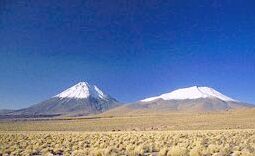 We
arrived in San Pedro de Atacama, Chile, on 10th December. San Pedro was a little oasis
town in the incredibly dry Atacama desert. It was quite a shock to the system with
temperatures around 35 Celsius and the prices about five times those of Bolivia!! We spent
a couple of days in San Pedro acclimatizing and then headed down to the coast. We found
that by buying food from the supermarkets and staying with families, we could keep the
costs under control - just! Next we traveled quickly down the coast of Chile to La Serena,
a beach resort. We found a great little family to stay with, and so we decided to hang-out
there for a few days, before continuing on down to Santiago for Christmas.
We
arrived in San Pedro de Atacama, Chile, on 10th December. San Pedro was a little oasis
town in the incredibly dry Atacama desert. It was quite a shock to the system with
temperatures around 35 Celsius and the prices about five times those of Bolivia!! We spent
a couple of days in San Pedro acclimatizing and then headed down to the coast. We found
that by buying food from the supermarkets and staying with families, we could keep the
costs under control - just! Next we traveled quickly down the coast of Chile to La Serena,
a beach resort. We found a great little family to stay with, and so we decided to hang-out
there for a few days, before continuing on down to Santiago for Christmas.
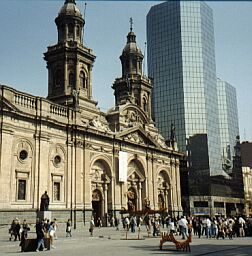
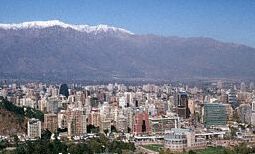 We had a real party time in Santiago. Santiago
was a very pleasant city, the weather was perfect and the people super friendly. Both
Christmas and New Year were very boozy times, we met up with a good group of travelers, so
every night seemed to be party night! Apart from the night-life we did a few excursions
including a visit to Chile´s largest vineyard, this was really interesting and I learnt
quite a bit about wine - the tour was free, but unfortunately we had to pay for the
tastings!
We had a real party time in Santiago. Santiago
was a very pleasant city, the weather was perfect and the people super friendly. Both
Christmas and New Year were very boozy times, we met up with a good group of travelers, so
every night seemed to be party night! Apart from the night-life we did a few excursions
including a visit to Chile´s largest vineyard, this was really interesting and I learnt
quite a bit about wine - the tour was free, but unfortunately we had to pay for the
tastings!